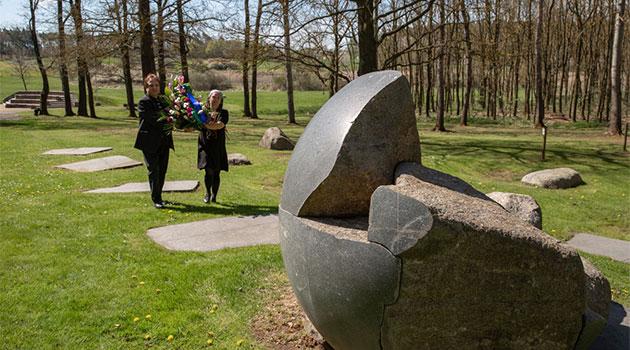Czech Govt commits to investigating property confiscated from Romani people during WWII in order to compensate them

An analysis should soon be undertaken in the Czech Republic to map the property owned by Romani people living in the Czech lands during the interwar period that was subsequently confiscated from them by authorities between 1938 and 1945 during the Nazi German occupation; the analysis should serve as a background material for establishing a compensation procedure. The new Strategy for the Equality, Inclusion and Participation of Roma 2021-2030 counts on performing such an analysis and was approved by the Czech Government at its most recent cabinet session.
According to the Holocaust.cz website, the authorities of the Protectorate of Bohemia and Moravia (1939–1945) ultimately deported more than 5 500 Romani people from the Czech lands to the Auschwitz death camp. After the war, roughly one-tenth of that 5 500 returned to their homes.
The website also reminds people of the Protectorate-era camps at Hodonín u Kunštátu and Lety u Písku and their role in that process. “The Government of the Czech Republic has not yet taken the step of fairly compensating Romani people for the property confiscated from them during the Second World War,” the new Strategy states.
According to that document, this would be an important, symbolic step in the process of reconciliation. The Strategy calls for producing an analysis of the property held by Romani and Sinti people living in Bohemia, Moravia and Silesia during the interwar period.
The analysis should then facilitate the creation of a compensation mechanism and the subsequent compensation of the victims. The Committee for the Redress of the Roma Holocaust in the Czech Republic, which brings together Holocaust victims who are Romani and their relatives, is meant to collaborate on the analysis with the Human Rights Section of the Office of the Czech Government and the Institute for the Study of Totalitarian Regimes.
According to the Strategy, because of the length of time that has passed since the war, it is necessary to attempt to acquire the background materials and information necessary to settling this issue as soon as possible. The cabinet, however, has approved a timeframe of 10 years for production of the analysis and establishing a compensation mechanism.
“The aim of this measure is to create a background material on the basis of which it might be possible to take further steps to establish a compensation mechanism and implement it by the year 2030,” the task section of the strategy states. Creation of such an analysis for compensation purposes was recommended a year and a half ago by the Czech Government Council for Romani Minority Affairs.
Czech Prime Minister Andrej Babiš (ANO) was asked to arrange for the Government to finance such research. The PM also serves as chair of the Council.
According to a census taken during the early 1920s, the entire country of Czechoslovakia had 56 300 inhabitants who were Romani. Of those, 579 lived in Bohemia and 2 139 lived in Moravia and Silesia, with most living in Slovakia.
The Moravian Romani people lived predominantly in settlements in the southeast of that region, while the Roma in Bohemia lived on the road. In 1927, Czechoslovakia adopted a “law on wandering cikáni“, which limited life on the road, according to the Holocaust.cz website.
According to that information source, however, the integration of Romani people on Czech territory had been proceeding naturally even without such a law. The authors of the Holocaust.cz project document that claim by noting that as of the 1930s, a Romani man from a settlement in the Kyjov area had graduated from law school.
Romani people most frequently made a living in those days as casual workers, craftspeople, day laborers and musicians. The Committee for the Redress of the Roma Holocaust has long been striving for a change in the approach taken by authorities toward the Romani victims of Nazism.
Among other matters, the nonprofit has achieved the removal of an industrial pig farm from the site of the Protecorate-era concentration camp for Romani people in Lety u Písku. The issue of compensation has also been raised by the Committee with German ministries.
In 2016, Germany awarded a one-time compensation payment of EUR 2 556 to Romani victims for their wartime suffering. Romani people from the Czech Republic were able to apply for such compensation through the Czech Foreign Ministry under certain conditions.
According to the Strategy, “The authorities do not have information about the exact number of Romani applicants compensated previously by the compensation programs for the victims of Nazism.” The authors of the Strategy assess the one-time payment that was offered to have been comparatively low.
In their view it is also problematic that the descendants of Romani victims have not been able to apply for compensation. According to the Strategy, the Committee is continuing to strive for Romani victims of Nazism to be compensated in a way that would be more similar to the compensation paid to Jewish victims of Nazism.
How the Strategy for the Equality, Inclusion and Participation of Roma 2021-30 was developed
The Department of the Office of the Czech Government Council for Romani Minority Affairs and the Secretariat of the Czech Government Council for National Minority Affairs prepared the first draft of the strategy and opened it for public consultation at the close of April 2020. Those consultations were meant to take place through an online questionnaire.
That approach was criticized by some members of the volunteer civil society section of the Czech Government Council for Romani Minority Affairs as well as by nonprofit organizations. According to the critics, Romani people had been insufficiently involved in drafting the strategy’s text and it had been submitted to them as a fait accompli.
Nonprofit organizations led by RomanoNet, which brings together several leading pro-Romani and Romani NGOs, called for the strategy to be reworked and were interested in contributing to it. The first joint session of working groups on the strategy happened on 24 June 2020 at the Impact Hub in Prague, where the strategy was revised and new aims and measures were proposed for it.
Until the close of November 2020, through video conferences, the specific content of the logframes and concrete tasks for each ministry was formulated. The final form of the text of the Strategy was also drafted.
The entire material was submitted to Czech Prime Minister Andrej Babiš for his signature on 10 December 2020, and on 17 December the material was sent to the inter-ministerial commenting procedure. On 19 April 2021 the Sstrategy was approved by the Czech Government Council for Romani Minority Affairs and on 10 May the Czech Government adopted it.
